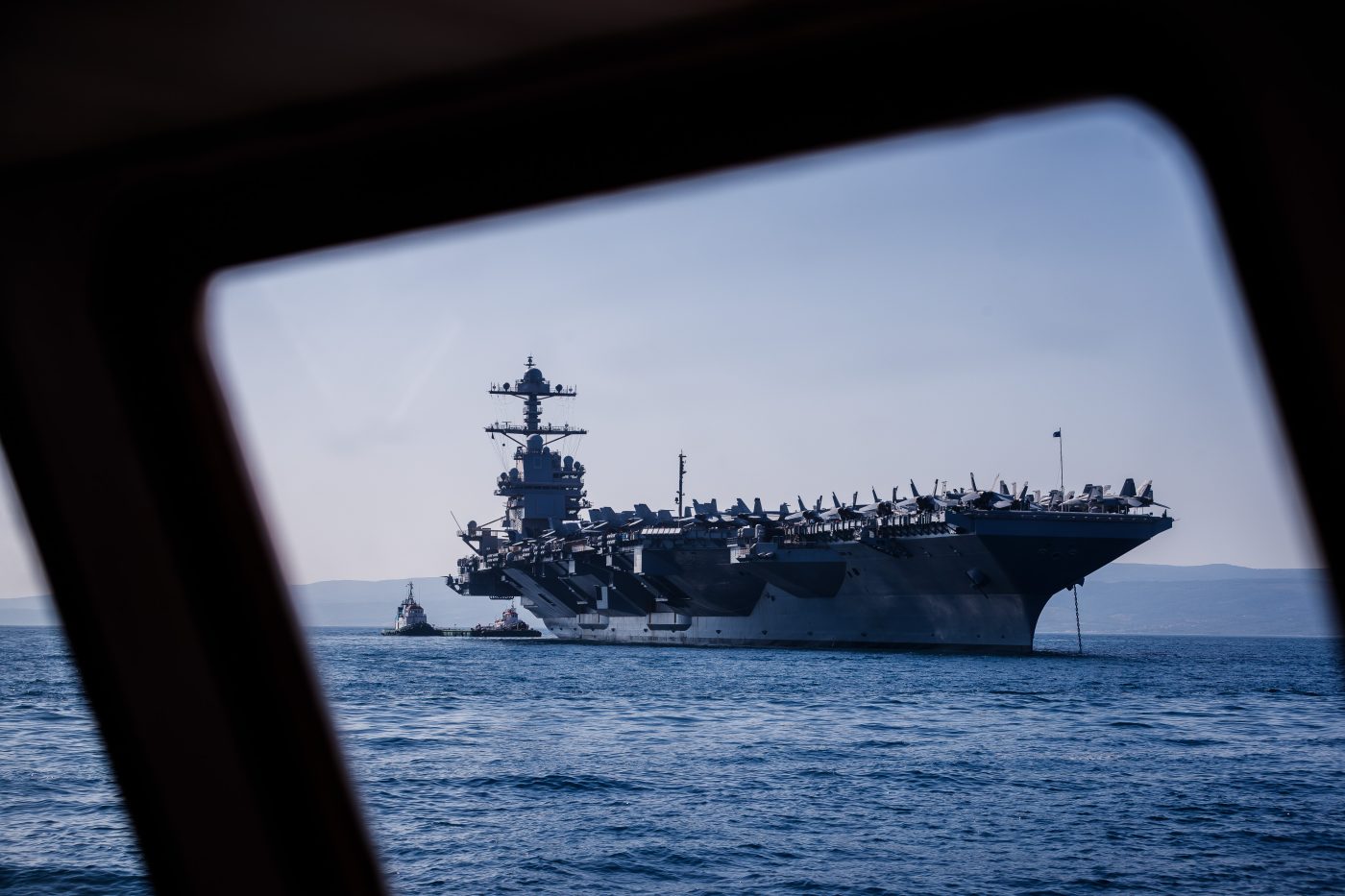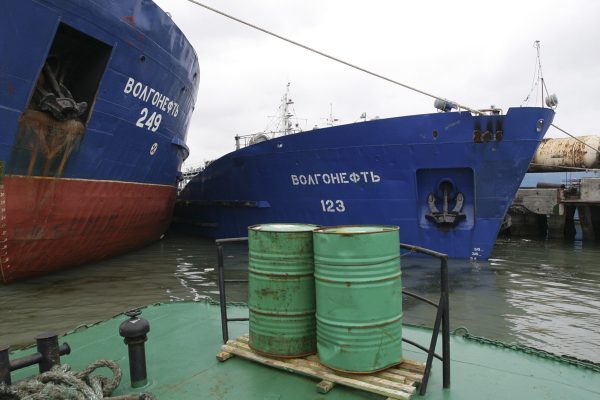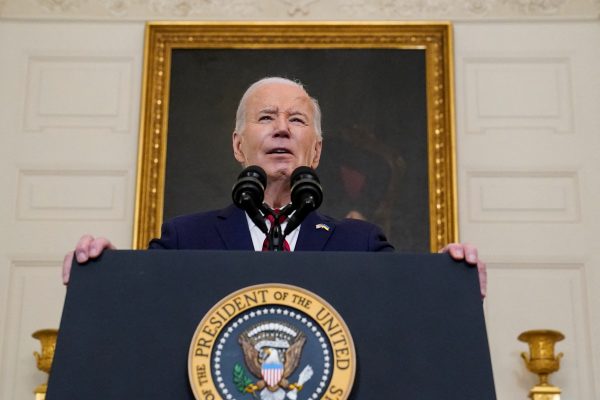The US Navy has assembled one of the greatest concentrations of power in the Eastern Mediterranean in 40 years. Any assumption that the large and growing US naval force in the region is simply there as a demonstration force, unlikely to be used, was dispelled on October 19 when the destroyer USS Carney shot down cruise missiles and drones in the northern Red Sea. The USN said the munitions had been launched from Yemen and were potentially aimed at Israel.
The US government has now deployed a very extensive range of naval force in the Eastern Mediterranean following the murderous Hamas attack against Israel on October 7.
The force will be composed of two carrier strike groups centered around the USS Gerald R. Ford and the USS Dwight Eisenhower, the latter currently on its way to the region. On October 21, the Eisenhower was redirected to the Arabian Sea to “assist in the defense of Israel.” The former had been scheduled to end its six-month deployment, but this has now been extended for an indeterminate period. Together, they have nine escorts.
In addition, the Biden administration is moving the USS Bataan Amphibious Ready Group (ARG) and embarked 26th Marine Expeditionary Unit (MEU) to the area. It has also been reported that the command ship USS Mount Whitney has deployed in support of Eastern Mediterranean operations, which suggests that the US might form a joint task force in the region with a senior officer taking command of that effort at sea on the command ship.
This combined force represents one of the largest US naval deployments in these waters since June 1983, when four US carrier groups were in the Eastern Mediterranean and, later in the year, when two carriers and the battleship USS New Jersey bombed and shelled terrorist positions in Lebanon. US Marines have also been present many times in the region and ran non-combatant evacuation operations from Beirut in the summer of 1983, before the barracks bombing. US naval forces are no strangers to the Eastern Mediterranean and its Byzantine mix of terrorist groups, many directly supported by the Islamist Iranian theocratic government.
They face a range of threats.
While Hamas has not used cruise missiles in past combat, two other terrorist groups, Hezbollah and the Yemeni Houthis, have both employed such weapons in combat, likely supplied by Iran. Some experts also worry that Hamas has developed so-called surprise weapons, including explosives-packed submersible drones that it may be holding back.
In 2006, Hezbollah attacked the Israeli warship INS Hanit with a cruise missile. The weapon did only minor damage, but other weapons sank a nearby merchant ship. In October 2016, the Yemeni Houthis fired Chinese-made cruise missiles at US warships in the Red Sea. These weapons missed or were shot down (details are still classified).
The Houthis were successful, however, in targeting and attacking the former US high-speed vessel Swift, then operated by the United Arab Emirates (UAE) as a transport ship. The vessel was hit by a C802 Chinese cruise missile, caught fire, and burned to the point of being a total loss. Cruise missiles, suicide boats like that which attacked the destroyer USS Cole in 2000, as well as drones (that have also been employed in the Russo-Ukraine war) could all threaten US naval forces, especially closer to shore.
Nonetheless, the US will soon have an impressive naval force assembled in the Eastern Mediterranean. This is unusual. US operations, at best, include just a few ships and, usually, no carriers. Deploying two allows their aircraft to fly 24-hour/round-the-clock missions.
This amounts to eight strike fighter squadrons, in addition to electronic warfare, airborne early warning aircraft, transport aircraft, and helicopters totaling upwards of 150 aircraft. The carriers’ cruiser and destroyer escorts are all Aegis warships equipped to track thousands of air, surface, subsurface, and land targets in the region, and the external links to track many thousands more, many through allies and partners in other regions that might affect the Eastern Mediterranean.
Just adding up all of the AEGIS ship vertical launch system (VLS) missile cells amounts to over 800 cells, assuming 122 in each of the cruisers and 90-96 in each of the six destroyers. No outward appearance suggests what types of weapons those cells hold, but they will include surface-to-air weapons capable of shooting down aircraft and cruise and ballistic missiles, as well as the well-known Tomahawk cruise missile.
The USS Bataan ARG, with its 2,400 embarked marines, is also en route. Centered around the Bataan, a large amphibious ship with MV-22 Osprey tilt-rotor aircraft, it has two additional amphibious warfare ships, as well as the Marines from a special operations capable unit. These amphibious ships can provide hospital capabilities, conduct non-combatant evacuation operations, and are also proficient at humanitarian assistance and disaster relief (HADR).
Together, these vessels represent a powerful, multidimensional naval force in the region capable of everything from high-tempo strikes to large-scale assistance operations. These capabilities are why national decision-makers turn to naval forces time and again to provide rapid and sustained responses in a crisis.
Do not, however, forget the downstream costs.
All of this impressive naval capability has a back-end cost often forgotten by many in the wake of a successful deployment. Naval capability is not unlimited, and deployments are carefully planned, and afterward the ships must allow time for maintenance and repair, as well as training and rest for the ships’ crews and Marines.
The US regularly has about 100 ships deployed around the world on any given day. That represents one-third of the entire force (now around 300 ships) and represents a significant commitment of naval capability. In the early 1990s, this commitment was easier, as the Navy had over 500 ships and could more easily sustain one-fifth of the force deployed than one-third.
Over the course of the 2000s and 2010s, there was a failure to properly follow up naval deployments with enough time for refit, repair, and rest. In 2020, the carriers Eisenhower and Theodore Roosevelt made nine-month deployments, the carrier Lincoln deployed for a whole year, and Eisenhower ended up with an extensive, 15-month-long repair period in the shipyard following back-to-back, closely consecutive deployments that year.
Many maintenance periods for carrier escorts have been deferred for months due to a lack of infrastructure to complete them or because there has simply been insufficient time given their operational commitments. Efforts to extend the life of the Ticonderoga-class Aegis cruisers have had mixed success due to the wear and tear on the ships over their 30-plus years of service, often in the absence of timely maintenance. This practice, akin to driving your car past the mileage on the dealer maintenance sticker, catches up with ships and results in more time out of service, more repairs, and higher costs.
This US Navy has long supported its Israeli counterpart. Aiding the embattled Israeli state and providing for possible, large-scale humanitarian assistance and evacuation operations is exactly the right thing to do. Naval forces are timely and capable components in executing these and similar US strategic objectives around the world.
That said, Congress and presidential administrations must remember the downstream costs of such operations and allow appropriate time and funding. Remember that naval forces must be ready to combat Chinese aggression and, at the same time, surge to the Mediterranean.
Congress and the Defense Department must fund and make time for post-deployment training, rest, and repair.
The clock is ticking in an increasingly dangerous world.
Admiral (rtd.) James G. Foggo III is a distinguished fellow at the Center for European Policy Analysis (CEPA) and former commander of US Naval Forces Europe and Africa and Allied Joint Force Command, Naples. He commanded BALTOPS in 2015 and 2016 and Exercise Trident Juncture in 2018.
Dr. Steven Wills currently serves as a navalist for the Center for Maritime Strategy at the Navy League of the US. He is an expert in US Navy strategy and policy. Wills had a 20-year career as an active-duty US Navy officer at sea and on shore-based assignments to the Defense Intelligence Agency and NATO.
Europe’s Edge is CEPA’s online journal covering critical topics on the foreign policy docket across Europe and North America. All opinions are those of the author and do not necessarily represent the position or views of the institutions they represent or the Center for European Policy Analysis.





